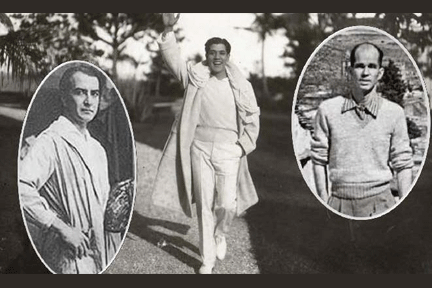The trio that transformed San Miguel [] History of Art in San Miguel
News Category: News, Art News, and Community News
-
Published February 7, 2023
By Natalie Taylor
The artistic renaissance of San Miguel de Allende came into full fruition in the late 1940s, and early 1950s, when the city became known as an international, artistic community. It is hard to imagine that this would have occurred if not for the vision of three artists—two foreigners, and one Mexican, and their meeting in San Miguel.
Jose Mojica was a Mexican tenor, and a popular movie star, who had moved to San Miguel de Allende in the early 30s. He bought a lovely home—today’s Villa Santa Monica Hotel—where he lived with his mother, and entertained many famous movie stars. While traveling through Mexico, Stirling Dickinson ran into Mojica, and after a brief conversation Mojica invited Dickinson to visit the city. Mojica had also met Felipe Cossio del Pomar in Mexico City, and had invited him to visit San Miguel as well.
Cossio del Pomar was a wealthy diplomat, and artist from Lima, Peru; and Dickinson was an equally wealthy artist from the United States. They each arrived here independently, and unfamiliar with one another, yet both felt an instant attraction to the city, and a parallel reaction. Both men reached the city at early dawn, and were puzzled at first sight, because their initial location—the train station—seemed bleak, and colorless. Both men wondered why they had even bothered to come to a god-forsaken place, a town that appeared to offer none of the beauty they had been promised.
That perception changed dramatically as each of them approached the center of town. The sun had begun to rise, coloring the sky in different hues, and the sudden vision of the pink spires of the Parroquia appeared, brilliantly illuminated by the rays of the sun. One can imagine the gasps of amazement as each man, at different times, was confronted by the vision.
“The light here is iridescent,” said Pomar, stunned by the beautiful colors of the sky and the buildings. “…the tiled domes reflect sapphires, emerald, [and] topaz,” he added. Dickinson, also awed by what he saw, simply said: “My gosh, what a place!” and within ten days bought a house in San Miguel, where he lived the rest of his life.
Pomar had traveled throughout South America looking for a spot for a Latin American school for the fine arts, and indigenous crafts. Once he met Dickinson, he shared the vision, and together with Jose Mojica they began to plan how to make this happen. The first thing was having the adequate space, and San Miguel had plenty of empty, colonial buildings. Following the War of Independence, which lasted from 1810 to 1821, the city had lost much of its population of wealthy Spaniards. The thriving economy based on tanning, agriculture, and other crafts had pretty much disappeared. Then followed a period of civil wars in the early decades of the 20th century, which depressed the entire country, and San Miguel as well. Old, magnificent buildings stood empty, slowly deteriorating. By the early 1920s, the population of San Miguel had gone from some 80,000 pre-War of Independence to less than 10,000. The city was on its way to becoming a ghost town.
This was the scenario Pomar, Mojica, and Dickinson found in the late 1930s. The three founded Amigos de San Miguel, a non-profit organization that focused on saving, and renovating the old buildings. But their primary vision was the establishment of an art school. They secured a meeting with then Mexican president Lazaro Cardenas, hoping to have the Las Monjas convent as the site for the school. The presentation must have been compelling, because Cardenas told them that if they could afford to run it, it was theirs.
The San Miguel Fine Arts School—Bellas Artes, opened its doors in 1938, with renowned artists agreeing to teach permanently, or temporarily—Diego Rivera, Carlos Merida, Rufino Tamayo, and Alexander Archipenko from Ukraine, among others. The curriculum covered paintings, ceramics, sculpture, engraving, muralism, and the history of art. Thus began the revival of our city and its place as one of the loveliest artistic centers in the world. And the foundation was laid for a city that was comfortable in accepting, and integrating foreigners into the community—Mojica, Pomar, and Dickinson were an example of that trend. This is reflected in today’s San Miguel where foreigners and locals live side by side, and continue to work together.
(To be continued)
Natalie Taylor: BA in English Lit and Journalism, Loyola University, Chicago, 1995. MFA in Creative Writing, Vermont College, Montpelier, VT, 1999. Published writer, editor, journalist. Spanish teacher in the US, English teacher in Buenos Aires, Argentina. Translator. www.natalietaylor.org Contact: tangonata@gmail.com


Leave a Reply